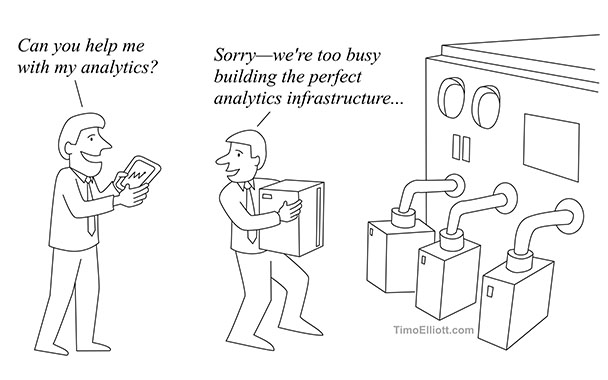Analytics teams have devoted the last few decades building large and elaborate infrastructures that attempt to gather and harmonize essential business data.
These systems are critically important to business. Yet a Forrester study found that 32% of business people felt their enterprise BI applications were too cumbersome to use, 31% have to wait days or weeks for an average BI request, and 45% said the systems didn’t contain the data they needed.
Data availability has exploded. The study found that on average, 45% of the data business people use now resides outside of the enterprise BI environments. The result is that approximately 63% of business decision-makers are using an equal amount or more of homegrown versus enterprise BI applications. And an astonishingly minuscule 2% of business decision-makers reported using solely enterprise BI applications.
The impact of this is clear: to succeed in the future, analytics teams have to own the business problem, not an infrastructure. They have to be focused on helping business people access information — wherever it is stored — and make better decisions, not just concentrate on building the perfect data warehouse or data lake.
When a business person has a problem, the answer can’t be “sorry, that data is not in the data warehouse — you’re on your own / come back in six months / you’ll have to pay us to include it”.
Whether the solution involves manual input of data into Excel, obtaining third-party data feeds, or spinning up a cloud-based Hadoop cluster, the analytics team should be the central point of contact for all discussions.
This may require a reorganization and some extra resources. But there are some big benefits. Today, many IT organizations believe they have strong governance rules in place, but this is constantly being undermined by business users dumping data to Excel. Business teams around the organization are already spending lots of time manually gathering and combining data. By centralizing these processes and being more pragmatic, organizations can save money, increase effective governance, improve the relationship between IT and business, and align data use more effectively with the real business needs of the organization.


Comments
4 responses to “Analytics Teams: Own The Business Problem, Not An Infrastructure”
[…] Finally, and perhaps most importantly: analytics teams should ensure that their own incentives are aligned with helping the business, not just building an analytics infrastructure. […]
Related to the point of the analytics team owning the problem, they also have to help own the question. Having worked in analytics teams as an outsider, the first question I ask the business owner is “what problem are you trying to solve?”
You’d be surprised how frequently there’s either no problem or a ridiculously trivial problem or–worse–the question being asked can’t help solve the problem! If you’ve done even a halfway competent job of setting up your analytics infrastructure, even if it’s powered by Excel and elbow grease, the chances are that you’ve got much of the relevant data somewhere.
Maybe not easily accessible, maybe not easy to slice and dice perfectly, but a lot of it’s there. But you’ve got to ask the right kinds of questions and make sure your business owners are focusing on solving problems that drive the business.
Now if the CxO asks for some in-depth analysis on a one-off event that impacted .2% of your customers, that’s a different question. A good idea is to dust off that proposal for a Hadoop cluster he/she nixed for cost reasons and say “if we only had this, you’d have had your answer by now…”
[…] Finally, perhaps most importantly: analytics teams should ensure that their own incentives are aligned with helping the business, not just building an analytics infrastructure. […]
“Data availability has exploded. The study found that on average, 45% of the data business people use now resides outside of the enterprise BI environments.”
This is a difficult problem that doesn’t have an easy solution. In order for insights to be gained, it’s important that all the data is accounted for. Incomplete data sets can lead to incomplete insights and poor decision-making.